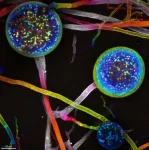(Press-News.org) Researchers from the University of Ottawa have discovered that plants may be able to control the genetics of their intimate root symbionts - the organism with which they live in symbiosis - thereby providing a better understanding of their growth.
In addition to having a significant impact on all terrestrial ecosystems, their discovery may lead to improved eco-friendly agricultural applications.
We talked to research lead Nicolas Corradi, Associate Professor in the Department of Biology and Research Chair in Microbial Genomics at the University of Ottawa, and lead author Vasilis Kokkoris, Postdoctoral Fellow in the Corradi Lab, to learn more about their recent study published in the journal Current Biology.
Can you tell us more about your findings?
Nicolas Corradi: "We have uncovered a fascinating genetic regulation between plants and their microbial symbionts, known as Arbuscular Mycorrhizal Fungi (AMF).
AMF are plant obligate symbionts that grow within the plant roots and help their hosts to grow better and be more resistant to environmental stressors.
AMF genetics have long been mysterious; while typical cells carry one nucleus, the cells of AMF carry thousands of nuclei that can be genetically diverse. How these nuclei communicate with each other and whether the plants can control their relative abundance, has been a total mystery.
Our work provides insights into this unique genetic condition:
1- We demonstrate that the host plant symbiont influences the relative abundance of thousands of co-existing nuclei carried by their fungal symbionts.
2- We find evidence that co-existing nuclei of different genetic backgrounds cooperate, rather than compete with one another thus potentially maximizing growth benefits for both the fungi and their plant partners."
How did you come to these conclusions?
Vasilis Kokkoris: "We implemented a novel molecular approach accompanied by advanced microscopy and mathematical modelling. Every single AMF spore carries hundreds of nuclei (see image).
By analyzing single spores, we were able to quantify the genetics of thousands of nuclei and define their relative abundance in different fungal strains and across plant species.
To ensure that we accurately analyze single nuclei, we used advanced microscopy to visualize and count the nuclei in the spores.
Lastly, we used mathematical modelling to prove that the observed abundance of nuclear genotypes we identified cannot be a product of luck but instead is the result of a driven cooperation between them.
To better understand what is regulating the AMF nuclei we grew different AMF strains with different hosts and found that plants have control of the relative abundance of the fungal nuclei."
What are the impacts of your discovery?
Nicolas Corradi: "For many years, AMF have been considered to be genetic peculiarities and far away from model organisms. Inconsistencies are commonly observed in plant-AMF experiments. For example, growing the same fungal strain with different plants can lead to drastically different plant yields. For a long time, this variance in plant growth was blamed on the AMF mysterious genetics.
Our research provides an answer as we demonstrate that the genetics of these fungi, and their effect on plant growth, can be manipulated by plants thus explaining the reason for the observed variability on plant growth.
From an environmental standpoint, this new knowledge allows for better understanding how plants can influence the genetics of their symbiotic partners, thus influencing entire terrestrial ecosystems.
From an economic standpoint, it opens doors to improved sustainable agricultural applications."
INFORMATION:
The research was led by the Corradi Lab, at the University of Ottawa and was conducted at the University of Ottawa and the Agriculture and Agri-Food Canada (AAFC). Two members of the Corradi lab, uOttawa PhD student Gökalp Yildirir and recent graduate Kelsey Clarke, also contributed to this study.
The other co-authors include Dr. Pierre-Luc Chagnon, Assistant Professor in the Department of biological sciences at the University of Montreal, Dr. Allyson M MacLean, Assistant Professor in the Department of Biology at the University of Ottawa and her MSc student Dane Goh, and Dr. Jeremy Dettman and Dr. Franck Stefani from the Agriculture and Agri-food Canada (Ottawa Research and Development Centre).
The paper "Host identity influences nuclear dynamics in arbuscular mycorrhizal fungi" is published in the journal Current Biology.
LA JOLLA, CA--As the opioid epidemic raged on with an even greater force during COVID-19, the Scripps Research laboratory of chemist Kim Janda, PhD, has been working on new therapeutic interventions that may be able to prevent the bulk of deaths from opioid overdose.
Janda and his team have developed experimental vaccines that have shown in rodents to blunt the deadly effects of fentanyl--which has been driving the boom in opioid deaths--as well as its even more fatal cousin, carfentanil, a growing source of overdoses and a chemical terrorist threat.
"Synthetic opioids are not only extremely deadly, but also addictive and easy to manufacture, making them a formidable public health threat, especially when the coronavirus crisis is negatively impacting mental health," says Janda, the Ely ...
A team of researchers led by Columbia University has developed a unique platform to program a layered crystal, producing imaging capabilities beyond common limits on demand.
The discovery is an important step toward control of nanolight, which is light that can access the smallest length scales imaginable. The work also provides insights for the field of optical quantum information processing, which aims to solve difficult problems in computing and communications.
"We were able to use ultrafast nano-scale microscopy to discover a new way to control our crystals with light, turning elusive photonic properties on and off at will," said Aaron Sternbach, postdoctoral researcher ...
Army scientists evaluated three nonhuman primate species as potential models of SARS-CoV-2 airborne infection, according to results published online this week in PLOS ONE. Their work demonstrates that any of these species may be useful for testing vaccines and therapies in response to the COVID-19 pandemic, which has resulted in over 104 million cases and more than 2 million deaths worldwide in the past year.
Given the global impact of COVID-19, experts are working rapidly to develop medical countermeasures, and testing in animal models is critically important to evaluate the efficacy of these products. Recent studies suggest that aerosol ...
Philadelphia, February 4, 2021 - Researchers have leveraged the latest advances in RNA technology and machine learning methods to develop a gene panel test that allows for highly accurate diagnosis of the most common types of liposarcoma. It quickly and reliably distinguishes benign lipomas from liposarcomas and can be performed in laboratories at a lower cost than current "gold standard" tests. The new assay is described in The Journal of Molecular Diagnosis, published by Elsevier.
"Liposarcomas are a type of malignant cancer that is difficult to diagnose because, even under a microscope, it is hard to differentiate liposarcomas from benign tumors or other types ...
An assessment published this week in the journal The Lancet HIV provides new insight about an initiative to integrate treatment of opioid use disorder along with HIV in Vietnam.
The study marks one of the first scientifically robust assessments of a new model of treating HIV in lower or middle income countries where injection drug use is a major cause of HIV infection. It also suggests the importance of building support for peer and community connections to tackle the opioid epidemic that continues to ravage the United States in the midst of the COVID-19 pandemic.
The study was led by scientists and physicians at Hanoi Medical University and Oregon Health & Science University.
"Our study suggests that countries that ...
WOODS HOLE, Mass. -- Egg cells start out as round blobs. After fertilization, they begin transforming into people, dogs, fish, or other animals by orienting head to tail, back to belly, and left to right. Exactly what sets these body orientation directions has been guessed at but not seen. Now researchers at the Marine Biological Laboratory (MBL) have imaged the very beginning of this cellular rearrangement, and their findings help answer a fundamental question.
"The most interesting and mysterious part of developmental biology is the origin of the body axis in animals," said researcher Tomomi Tani. An MBL scientist in the Eugene Bell Center at the time of the research, Tani is now with Japan's National Institute of Advanced Industrial Science and Technology.
The work by Tani and ...
CHAMPAIGN, Ill. -- Chemical manufacturers frequently use toxic solvents such as alcohols and benzene to make products like pharmaceuticals and plastics. Researchers are examining a previously overlooked and misunderstood phenomenon in the chemical reactions used to make these products. This discovery brings a new fundamental understanding of catalytic chemistry and a steppingstone to practical applications that could someday make chemical manufacturing less wasteful and more environmentally sound.
The study led by University of Illinois Urbana-Champaign researcher David Flaherty, University of Minnesota, Twin Cities researcher Matthew Neurock and Virginia Tech researcher Ayman Karim is published in the journal Science.
Combining ...
For more than a century, optical coatings have been used to better reflect certain wavelengths of light from lenses and other devices or, conversely, to better transmit certain wavelengths through them. For example, the coatings on tinted eyeglasses reflect, or "block out," harmful blue light and ultraviolet rays.
But until now, no optical coating had ever been developed that could simultaneously reflect and transmit the same wavelength, or color.
In a paper in Nature Nanotechnology, researchers at the University of Rochester and Case Western Reserve University describe a new class of optical coatings, so-called Fano Resonance Optical Coatings (FROCs), that can be used on filters to reflect and transmit colors of remarkable purity.
In addition, ...
The rapid development of silicon-based transistors leads to its integration getting closer to the limit of Moore's law. Graphene is expected to become the next generation of mainstream chip materials due to its ultra-high carrier mobility. However, it is difficult to obtain a high on/off current ratio for intrinsic graphene-based transistor owing to the absence of bandgap. Graphene nanoribbons, which possess a tunable bandgap and unique optoelectrical properties, have attracted extensive attention and exploration.
Nowadays, the preparation of graphene nanoribbons is underdeveloped, and common strategies include the clip of carbon materials (graphene films, carbon nanotubes, or graphite) ...
When we think about the links to the future - the global transition to solar and wind energy, tactile virtual reality or synthetic neurons - there's no shortage of big ideas. It's the materials to execute the big ideas - the ability to manufacture the lithium-ion batteries, opto-electronics and hydrogen fuel cells - that stand between concept and reality.
Enter two-dimensional materials, the latest step in innovation. Consisting of a single layer of atoms, two-dimensional materials like graphene and phosphorene exhibit new properties with far-reaching potential. With a capability to be combined like Lego bricks, these materials ...





